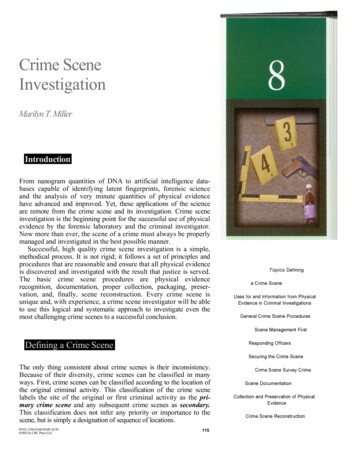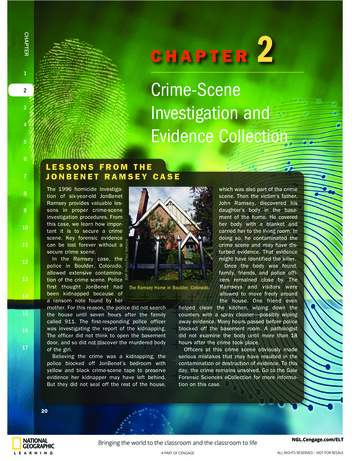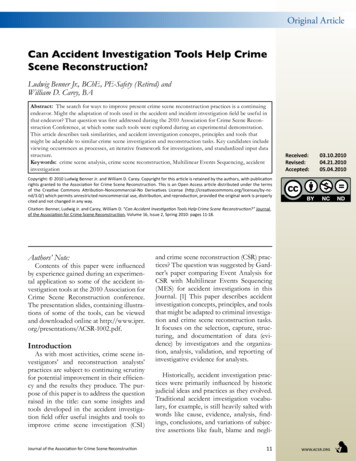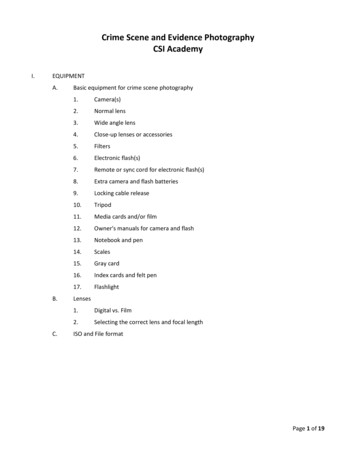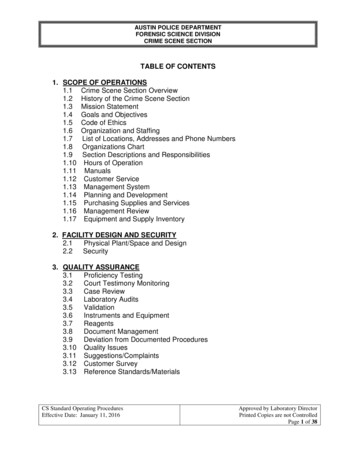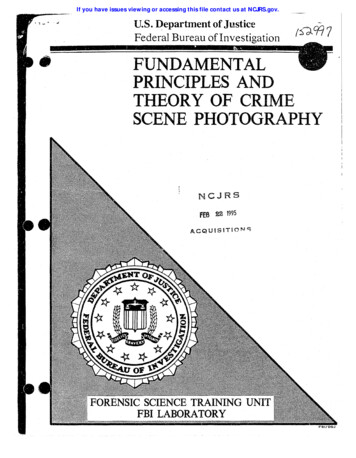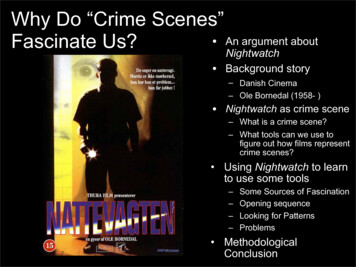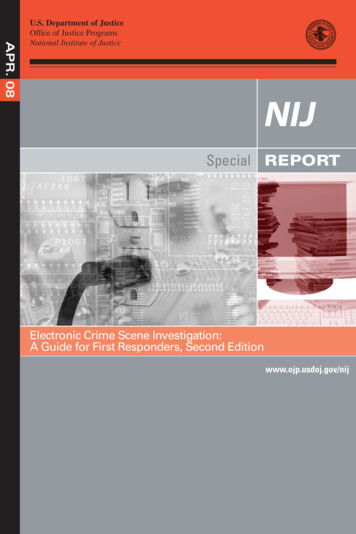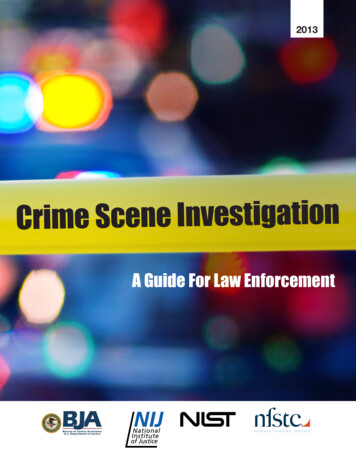
Transcription
2013Crime Scene InvestigationA Guide For Law EnforcementBureau of Justice AssistanceU.S. Department of Justice
CRIME SCENE INVESTIGATIONA Guide for Law EnforcementCrime Scene InvestigationA Guide for Law EnforcementSeptember 2013Original guide developed and approved by the Technical WorkingGroup on Crime Scene Investigation, January 2000.Updated guide developed and approved by the Review Committee,September 2012.Project Director: Kevin LothridgeProject Manager: Frank FitzpatrickNational Forensic Science Technology Center7881 114th Avenue NorthLargo, FL 33773www.nfstc.orgi
CRIME SCENE INVESTIGATIONA Guide for Law EnforcementRevision of this guide was conducted by the National ForensicScience Technology Center (NFSTC), supported under cooperativeagreements 2009-D1-BX-K028 and 2010-DD-BX-K009 by theBureau of Justice Assistance, and 2007-MU-BX-K008 by the NationalInstitute of Justice, Office of Justice Programs, U.S. Department of Justice.This document is not intended to create, does not create, and maynot be relied upon to create any rights, substantive or procedural,enforceable at law by any party in any matter, civil or criminal.Opinions or points of view expressed in this document represent aconsensus of the authors and do not necessarily reflect the officialposition of the U.S. Department of Justice.www.nfstc.orgii
CRIME SCENE INVESTIGATIONA Guide for Law EnforcementContentsA. Arriving at the Scene: Initial Response/ Prioritization of Efforts . 11.Initial Response/ Receipt of Information . 12.Safety Procedures . 23.Emergency Care . 24.Secure and Control Persons at the Scene. 35.Boundaries: Identify, Establish, Protect and Secure. 46.Turn Over Control of the Scene and Brief Investigator(s) in Charge . 67.Document Actions and Observations . 68.Establish a Command Post (Incident Command System) and Make Notifications. 79.Manage Witnesses. 8B. Preliminary Documentation and Evaluation of the Scene . 101.Conduct Scene Assessment.102.Conduct Scene “Walk-Through” and Initial Documentation .113.Note-Taking and Logs .13C. Processing the Scene. 151.Determine Team Composition .152.Ensure Contamination Control .153.Documentation .16Sketching . 17Photography. 27Videography . 354.Prioritize Collection of Evidence .385.Crime Scene Search Methods .396.Collect, Preserve, Inventory, Package, Transport, and Submit Evidence .427.Detailed Crime Scene Evidence Collection .42Ignitable Liquids . 43Bodily Fluids . 43Male Suspect Evidence Collection, Including Sexual Assault . 54Bombs and Explosives . 56www.nfstc.orgiii
CRIME SCENE INVESTIGATIONA Guide for Law EnforcementDocuments . 57Firearms. 61Ammunition . 67Tool Mark Evidence . 71Trace Evidence . 73Footwear and Tire Impressions . 98Footwear Impression Evidence. 101Motor Vehicles . 111Electronic and Digital Evidence . 113Fingerprints . 134Comparison/Elimination Prints . 139Tool Mark Evidence . 142D. Completing and Recording the Crime Scene Investigation . 1451.Establish Crime Scene Debriefing Team . 1452.Perform Final Survey of the Crime Scene . 1463.Documentation of the Crime Scene . 1464.Acknowledge Specialized Crime Scene Circumstances . 147Crime Scene Investigation in Correctional and Custodial Facilities . 148Time-Limited Crime Scene Investigation . 149E. Crime Scene Equipment . 1501.Initial Responding Officer(s) . 1502.Crime Scene Investigator/Evidence Technician . 1513.Evidence Collection Kits (Examples). 153F. Appendices . iAppendix A. Glossary. iiAppendix B. Reference List .viiiAppendix C. Diagrams . xwww.nfstc.orgiv
CRIME SCENE INVESTIGATIONA Guide for Law EnforcementAcknowledgementsThis updated Crime Scene Investigation: A Guide to LawEnforcement is a revision of the original publication published inJanuary 2000, and borrows heavily from that work. The originalpublication was based upon the work of the National Crime ScenePlanning Panel and additional Technical Working Group Members.Their contributions remain as vital today as when the original Guidewas published.To develop this expanded edition, a Review Committee ofrecognized experts was assembled. This committee selectedadditional material from content developed for Department ofJustice funded crime scene projects, Scientific Working Groups andother open-source documents, which are reflected in the Referencesection. Additional vetting of the material was accomplished throughrecognized subject matter experts.NFSTC wishes to thank the Bureau of Justice Assistance (BJA), theNational Institute of Standards and Technology (NIST) and theNational Institute of Justice (NIJ) for providing input to this project.The resulting document includes detailed procedural guides for thecomplete range of crime scene investigation tasks – from securing thescene to submitting the evidence. This publication provides lawenforcement professionals and first responders step-by-step guidancein this crucial first phase of the justice process.Agencies are encouraged to use this reference to enhance existingtraining and promote quality. While these methods can beimplemented at any agency, jurisdictions will want to carefullyconsider the procedures and their applicability to local agencies andcircumstances.www.nfstc.orgv
CRIME SCENE INVESTIGATIONA Guide for Law EnforcementNational Crime Scene Planning Panel(NCSPP)January 2000Dr. José R. Almirall, Associate Director/Assistant ProfessorInternational Forensic Research InstituteDepartment of ChemistryFlorida International UniversityMiami, FloridaSusan Ballou, Forensic ScientistMontgomery County Police DepartmentCrime LaboratoryRockville, MarylandPaul Carroll, Sergeant (Ret.)Chicago Police DepartmentBig Pine Key, FloridaElizabeth Farris, Chief Trial CounselHampden County District Attorney’s OfficeSpringfield, MassachusettsJo Ann Given, ASCLD/LABNaval Criminal Investigative ServiceNorfolk, VirginiaLarry McCann, Senior Special Agent (Ret.)Virginia State PoliceRichmond, VirginiaDr. Joseph L. PetersonDepartment of Criminal JusticeUniversity of IllinoisChicago, IllinoisElliot B. Spector, DirectorCenter for Police and Security TrainingSuffield, ConnecticutAnn Talbot, ASCLD/LABAlbuquerque Police DepartmentAlbuquerque, New MexicoJames T. “Tom” Thurman, AssociateProfessorCollege of Law EnforcementEastern Kentucky UniversityRichmond, KentuckyMarjorie Harris, Senior Forensic ScientistDepartment of Criminal JusticeDivision of Forensic ScienceRichmond, Virginiawww.nfstc.orgvi
CRIME SCENE INVESTIGATIONA Guide for Law EnforcementAdditional Technical Working GroupMembersHal R. Arenstein, Attorney at LawLaw Offices of Hal ArensteinCincinnati, OhioDexter J. Bartlett, InspectorIllinois State PoliceCrime Scene Services CommandJoliet, IllinoisEric Buel, DirectorDepartment of Public SafetyCrime LaboratoryWaterbury, VermontJeff Cover, SupervisorCrime Scene UnitAnne Arundel County Police DepartmentMillersville, MarylandElizabeth Devine, Supervising CriminalistScientific Services BureauLos Angeles County Sheriff’s DepartmentLos Angeles, CaliforniaHenry Escobar, DetectiveSan Antonio Police DepartmentSan Antonio, TexasJerry N. Estes, District Attorney General10th Judicial DistrictAthens, TennesseeJames Estrada, Detective InvestigatorHomicide UnitSan Antonio Police DepartmentSan Antonio, TexasDrew Findling, AttorneyAtlanta, Georgiawww.nfstc.orgNan Horvat/John SarconeAssistant Polk County Attorney/ Polk CountyAttorneyDes Moines, IowaN. Michael Hurley, Regional DirectorOregon State PoliceForensic Services DivisionSpringfield, OregonGary L. Kaldun, Forensic Scientist, CrimeScene CoordinatorBureau of Criminal ApprehensionSt. Paul, MinnesotaJoe Marchan, Supervising CriminalistTexas Department of PublicSafety Crime LaboratoryMcAllen, TexasJoseph John Moseley, II, DetectiveCentral Homicide Evaluation Support SquadChicago Police DepartmentChicago, IllinoisRobert Mullins, Detective InvestigativeServicesNew Haven Police DepartmentNew Haven, ConnecticutSteve Nash, DetectiveMarin County Sheriff’s DepartmentSan Rafael, CaliforniaKathryn Normington-Hollenbach, SeniorForensic ScientistWyoming State Crime LaboratoryCheyenne, Wyomingvii
CRIME SCENE INVESTIGATIONA Guide for Law EnforcementGalen Paine, Assistant Public DefenderPublic Defender’s OfficeSitka, AlaskaMichael J. Rafferty, Chief of ForensicsFlorida Department of Law EnforcementFort Myers Regional Operations CenterFort Myers, FloridaEugene Rifenburg, Senior Investigator (Ret.)New York State Police Investigator (current)Oneida Nation PoliceMunnsville, New YorkGary A. Rini, Police Commander (Ret.)DirectorThe American Institute for Police ScienceElkhorn, NebraskaHeidi Robbins, Supervising CriminalistScientific Services BureauLos Angeles County Sheriff’s DepartmentLos Angeles, CaliforniaDarrell Ryan, LieutenantNashville Police DepartmentNashville, TennesseeNorman Shapiro, Vice PresidentNew York State Defender’s AssociationCounselor at LawLaw Offices of Norman ShapiroMiddletown, New YorkClarene Shelley, LieutenantLakewood Police DepartmentLakewood, Coloradowww.nfstc.orgGregory Smith, Assistant County ProsecutorOffice of the County ProsecutorCamden CountyCamden, New JerseyRichard Stanek, CaptainMinneapolis Police DepartmentMinneapolis, MinnesotaBrad Townsend, SergeantCorona Police DepartmentCorona, CaliforniaLarry Turner, Director of Forensic ServicesJackson Police Department Crime LaboratoryJackson, MississippiStephen Weichman, County and ProsecutingAttorneyTeton CountyJackson, WyomingJames Wiser, Crime Scene Investigator/Evidence CustodianMount Pleasant Police DepartmentMount Pleasant, South CarolinaLarry Wood, DetectiveMajor Case UnitSmyrna Police DepartmentSmyrna, GeorgiaJohn Yarbrough, Sergeant Homicide BureauLos Angeles County Sheriff’s DepartmentCommerce, Californiaviii
CRIME SCENE INVESTIGATIONA Guide for Law EnforcementReview CommitteeGregory B. Bailey, Evidence Technician(Ret.)Contract Assessor, Forensic Quality ServicesBerkley, MichiganSgt. Jim Markey, M.EdConsultant/TrainerInvestigative Lead, LLCFountain Hills, AZDetective Brian Cochran, TeachingAssociateNational Forensic AcademyBoone County, KentuckyCory Latham, CSCSA, CBPETeaching AssociateNational Forensic AcademyOak Ridge, TennesseeRobert C. Gaffney, CSCSASpecial Agent/Operations OfficerForensic Research and Training DivisionUS Army Criminal Investigation LaboratoryForest Park, GeorgiaWayne Moorehead, F-ABC, F-AAFSForensic ConsultantforensicTRACERancho Santa Margarita, CaliforniaLesley Hammer, D-ABC, CSCSA, CFWEForensic ExaminerHammer ForensicsAnchorage, AlaskaJoseph Heppler, Computer Forensic TeamLeadCACI Contractor for U.S. Dept of StateComputer Investigations and ForensicsArlington, VirginiaMike James, Assistant Sheriff (Retired)Orange County Sheriff's DepartmentOrange County, CaliforniaGregory S. Klees, Firearms and ToolmarkExaminerBureau of Alcohol, Tobacco, Firearms andExplosivesAmmendale, Marylandwww.nfstc.orgSteve O'Dell, CSCSA, CBPESenior Police AdvisorSenior Forensic Laboratory ManagementAdvisorInternational Narcotics and Law EnforcementUS Department of StateWashington, DCJoseph L. Parker, D-ABFDEForensic Document ExaminerAtlanta Forensic Document ExaminerServices, Inc.Peachtree City, GeorgiaRodney A. Schenck, CLPE, CFWE, CCSAPhysical Scientist, Forensic Latent PrintExaminerU.S. Army Criminal Investigation LaboratoryExpeditionary Forensic DivisionForest Park, GeorgiaElizabeth Thompson, DNA LaboratoryDirectorOrange County Crime LaboratoryOrange County Sheriff-CoronerOrange County, Californiaix
CRIME SCENE INVESTIGATIONA Guide for Law EnforcementCrime Scene InvestigationA Guide for Law EnforcementSection AArriving at the Scene: InitialResponse/Prioritization of EffortsSection BPreliminary Documentation andEvaluation of the SceneSection CProcessing the SceneSection DCompleting and Recording theCrime Scene InvestigationSection ECrime Scene EquipmentAuthorization: Actions taken pursuant to this guide shall beperformed in accordance with department policies and procedures andFederal and State laws.www.nfstc.orgx
CRIME SCENE INVESTIGATIONA Guide for Law EnforcementThis handbook is intended as a guide to recommended practices forcrime scene investigation.Jurisdictional, logistical, or legal conditions may preclude the use ofparticular procedures contained herein.For potentially devastating situations, such as biological weapons orradiological or chemical threats, the appropriate agencies should becontacted. The user should refer to the National Institute of Justice’spublications for fire and arson investigation, bomb and explosivesinvestigation, electronic crime investigation, and death investigationwhere applicable.www.nfstc.orgxi
CRIME SCENE INVESTIGATIONA Guide for Law EnforcementA.Arriving at the Scene: InitialResponse/ Prioritization ofEffortsNote : Words and phrases that are defined in the glossary appearin bold italics on their first appearance in the body of the Guide.1. Initial Response/ Receipt ofInformationPrinciple: One of the most important aspects of securing thecrime scene is to preserve the scene with minimal contaminationand disturbance of physical evidence. The initial response to anincident should be expeditious and methodical.Policy: The initial responding officer(s), upon arrival, shall assessthe scene and treat the incident as a crime scene. They shall promptly,yet cautiously, approach and enter the crime scene, remainingobservant of any persons, vehicles, events, potential evidence, andenvironmental conditions.Procedure: The initial responding officer(s) should:a. Note or log dispatch information (e.g., address/location, time,date, type of call, parties involved).b. Be aware of any persons or vehicles leaving the crime scene.c. Approach the scene cautiously, scan the entire area tothoroughly assess the scene, and note any possible secondarycrime scenes.d. Be aware of any persons and vehicles in the vicinity that may berelated to the crime.e. Make initial observations (look, listen, smell) to assess the sceneand ensure officer safety before proceeding.f. Remain alert and attentive. Assume the crime is ongoing untildetermined to be otherwise.g. Treat the location as a crime scene until assessed and determinedto be otherwise.h. Safely direct additional responding units into the area.www.nfstc.orgA. Arriving at the Scene: Initial Response/Prioritization of Efforts 1
CRIME SCENE INVESTIGATIONA Guide for Law EnforcementSummary: It is important for the initial responding officer(s) tobe observant when approaching, entering, and exiting a crime scene.2. Safety ProceduresPrinciple: The safety and physical well-being of officers and otherindividuals, in and around the crime scene, are the initial respondingofficer(s’) first priority.Policy:The initial responding officer(s) arriving at the scene shallidentify and control any dangerous situations or persons.Procedure: The initial responding officer(s) should:a. Ensure that there is no immediate threat to other responders ;scan area for sights, sounds, and smells that may present dangerto personnel (e.g., hazardous materials such as gasoline, naturalgas). If the situation involves a clandestine drug laboratory,biological weapons , or radiological or chemical threats theappropriate personnel/agency should be contacted prior toentering the scene.b. Approach the scene in a manner designed to reduce risk of harmto officer(s) while maximizing the safety of victims, witnesses,and others in the area.c. Survey the scene for dangerous persons and control thesituation.d. Notify supervisory personnel and call for assistance/backup.Summary: The control of physical threats will ensure the safetyof officers and others present.3. Emergency CarePrinciple: After controlling any dangerous situations or persons,the initial responding officer(s’) next responsibility is to ensure thatmedical attention is provided to injured persons while minimizingcontamination of the scene.Policy: The initial responding officer(s) shall ensure that medicalattention is provided with minimal contamination of the scene.Procedure: The initial responding officer(s) should:www.nfstc.orgA. Arriving at the Scene: Initial Response/Prioritization of Efforts 2
CRIME SCENE INVESTIGATIONA Guide for Law Enforcementa. Assess the victim(s) for signs of life and medical needs andprovide immediate medical attention.b. Call for medical personnel.c. Guide medical personnel to the victim to minimizecontamination/alteration of the crime scene.d. Point out potential physical evidence to medical personnel,instruct them to minimize contact with such evidence (e.g.,ensure that medical personnel preserve all clothing and personaleffects without cutting through bullet holes, knife tears), anddocument movement of persons or items by medical personnel.e. Instruct medical personnel not to “clean up” the scene and toavoid removal or alteration of items originating from the scene.f. If medical personnel arrived first, obtain the name, unit, andtelephone number of attending personnel, and the name andlocation of the medical facility where the victim is to be taken.In some instances, fingerprint and shoe impressions of medicalpersonnel may need to be taken for elimination purposes.g. If there is a chance the victim may die, attempt to obtain “dyingdeclaration .”h. Document any statements/comments made by victims, suspects,or witnesses at the scene.i.If the victim or suspect is transported to a medical facility, senda law enforcement official with the victim or suspect todocument any comments made and preserve evidence. (If noofficers are available to accompany the victim/suspect, stay atthe scene and request medical personnel to preserve evidenceand document any comments made by the victim or suspect.)j.Safeguard evidence, such as a weapon, that is taken into custody.Follow chain-of-custody procedures as soon as the evidence isconfiscated.Summary: Assisting, guiding, and instructing medical personnelduring the care and removal of injured persons will diminish the riskof contamination and loss of evidence.4. Secure and Control Persons at theScenePrinciple: Controlling, identifying and removing persons at thecrime scene, and limiting the number of persons who enter the crimewww.nfstc.orgA. Arriving at the Scene: Initial Response/Prioritization of Efforts 3
CRIME SCENE INVESTIGATIONA Guide for Law Enforcementscene and the movement of such persons is an important function ofthe initial responding officer(s) in protecting the crime scene.Policy: The initial responding officer(s) shall identify persons at thecrime scene and control their movement.Procedure: The initial responding officer(s) should:a. Control all individuals at the scene—prevent individuals fromaltering/destroying physical evidence by restricting movement,location and activity while ensuring and maintaining safety at thescene.b. Identify all individuals at the scene, such as: Suspects: Secure and separate.Witnesses: Secure and separate.Bystanders: Determine whether witness, if so treat asabove; if not, remove from the scene.Victims/family/friends: Control while showingcompassion.Law Enforcement, Medical and other assisting personnel.c. Exclude unauthorized and nonessential personnel from thescene (e.g., law enforcement officials not working the case,politicians, media).Summary: Controlling the movement of persons at the crimescene and limiting the number of persons who enter the crime sceneis essential to maintaining scene integrity, safeguarding evidence andminimizing contamination.5. Boundaries: Identify, Establish,Protect and SecurePrinciple: Defining and controlling boundaries provide a meansfor protecting and securing the crime scene(s). The number of crimescenes and their boundaries are determined by their location(s) andthe type of crime. Boundaries are established beyond the initial scopeof the crime scene(s) with the understanding that the boundaries canbe reduced in size if necessary but cannot be as easily expanded.Policy: The initial responding officer(s) at the scene shall conductan initial assessment of the extent of the crime scene(s) and thenestablish and control its boundaries.www.nfstc.orgA. Arriving at the Scene: Initial Response/Prioritization of Efforts 4
CRIME SCENE INVESTIGATIONA Guide for Law EnforcementProcedure: The initial responding officer(s) should:a. Establish boundaries of the scene(s), starting at the focal pointand extending outward to include: Where the crime occurred.Potential points and paths of exit and entry of suspects andwitnesses.Places where the victim/evidence may have been moved(be aware of trace and impression evidence whileassessing the scene).b. Secure the scene. Set up physical barriers (e.g., ropes, cones,crime scene barrier tape, available vehicles, personnel, otherequipment) or use existing boundaries (e.g., doors, walls, gates).c. Document the entry/exit of all people entering and leaving thescene, once boundaries have been established.d. Protect the scene. Control the flow of personnel and animalsentering and leaving the scene to maintain integrity of the scene.e. Institute measures to preserve/protect evidence that may be lostor compromised (e.g., protect from the elements (rain, snow,wind) and from footsteps, tire tracks, sprinklers).f. Document the original location of the victim or any objects thatyou observe being moved.g. Consider search and seizure issues to determine the necessity ofobtaining consent to search and/or obtaining a search warrant.Note: Persons should NOT smoke, chew tobacco, use the telephoneor bathroom, eat or drink, move any items from the scene includingweapons (unless necessary for the safety and well-being of persons atthe scene), adjust the thermostat or open windows or doors (maintainscene as found), touch anything unnecessarily (note and documentany items moved), reposition moved items, litter, or spit within theestablished boundaries of the scene. Do not allow suspect to usebathroom facilities, or to alter his/her appearance, including brushinghair or washing hands.Summary: Establishing boundaries is a critical aspect incontrolling the integrity of evidentiary material.www.nfstc.orgA. Arriving at the Scene: Initial Response/Prioritization of Efforts 5
CRIME SCENE INVESTIGATIONA Guide for Law Enforcement6. Turn Over Control of the Scene andBrief Investigator(s) in ChargePrinciple: Briefing the investigator(s) taking charge assists incontrolling the crime scene, helps establish further investigativeresponsibilities and assists with the managing of resources.Policy: The initial responding officer(s) at the scene shall provide adetailed crime scene briefing to the investigator(s) in charge of thescene.Procedure: The initial responding officer(s) should:a. Brief the investigator(s) taking charge.b. Assist in controlling the scene.c. Turn over responsibility for the documentation of entry/exit.d. Remain at the scene until relieved of duty.Summary: The scene briefing is the only opportunity for the nextin command to obtain initial aspects of the crime scene prior tosubsequent investigation.7. Document Actions and ObservationsPrinciple: All activities conducted and observations made at thecrime scene must be documented as soon as possible after the eventto preserve information.Policy: The initial responding officer(s) shall maintaindocumentation as a permanent record.Procedure: The initial responding officer(s) should document:a. Observations of the crime scene, including the location ofpersons and items within the crime scene and the appearanceand condition of the scene upon arrival.b. Conditions upon arrival (e.g., lights on/off; shades up/down,open/closed; doors and windows open/closed; smells; ice,liquids; movable furniture; weather; temperature; and personalitems.)c. Personal information from witnesses, victims, suspects and anystatements or comments made.www.nfstc.orgA. Arriving at the Scene: Initial Response/Prioritization of Efforts 6
CRIME SCENE INVESTIGATIONA Guide for Law Enforcementd. Their own actions and actions of others.Summary: The initial responding officer(s) at the crime scenemust produce clear, concise, documented information encompassinghis or her observations and actions.This documentation is vital in providing information to substantiateinvestigative considerations.8. Establish a Command Post (IncidentCommand System) and MakeNotificationsPrinciple: Setting up a location where crime scene investigationactivities can be coordinated, media meetings can be held, and teammeetings can occur is very valuable. This command post provides acentral location for crime scene investigation activities andassessment of resources. The activities also relate to ensuring thatother key investigative participants are told of the investigation andincluded in activities as needed.Policy: The investigator(s) in charge shall set up a location wherecrime scene investigation activities can be coordinated, mediameetings can be held, and team meetings can occur.Procedure: The investigator(s) in charge should:a. Set up a temporary command post in a location where mediacan take necessary photographs without jeopardizing the scene(and evidence) security.b. Notify investigators or appropriate department(s) (such asHomicide) of in
CRIME SCENE INVESTIGATION A Guide for Law Enforcement www.nfstc.org v Acknowledgements This updated Crime Scene Investigation: A Guide to Law Enforcement is a revision of the original publication published in January 2000, and borrows heavily from that work. The original publication was based upon the work of the National Crime Scene

